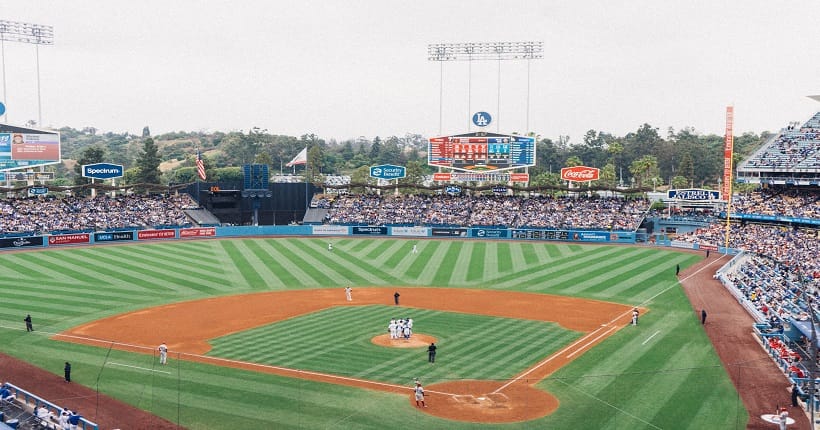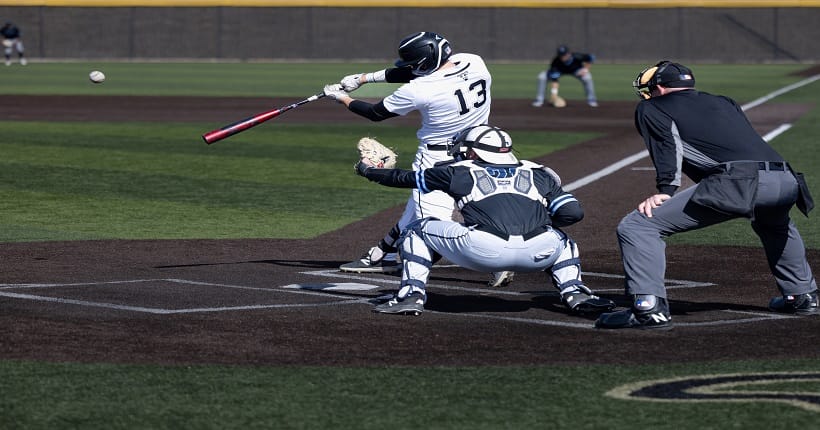How Many Acres Is A Baseball Field?
A standard baseball field encompasses approximately 1.75 acres. Baseball fields typically cover an area of around 1.75 acres, providing ample space for players to display their skills and for spectators to enjoy the game.
The size of a baseball field may vary slightly depending on the league and level of play, but the average field has dimensions that consist of a grassy outfield and an infield with a pitcher’s mound, bases, and a home plate.
The outfield is usually spacious, providing room for outfielders to chase down fly balls, while the infield is smaller and more compact, facilitating quick and precise defensive plays. A baseball field is meticulously designed to provide an optimal playing surface for the game of baseball, ensuring an exciting and enjoyable experience for all involved.

Credit: en.wikipedia.org
The Dimensions Of A Baseball Field
A baseball field has a distinctive layout with specific measurements that determine its dimensions. These dimensions play a crucial role in the game, affecting how players position themselves and strategize their plays. By understanding the standard size of a baseball field, we gain insight into the intricacies of America’s favorite pastime. In this article, we will delve into the topic, exploring the standard measurements and the layout of a baseball field.
Standard Baseball Field Measurements
The dimensions of a standard baseball field vary depending on the level of play, from Little League to Major Leagues. Here are the typical measurements you will find in a professional baseball field:
| Measurement | Distance |
|---|---|
| Pitcher’s Mound to Home Plate | 60 feet, 6 inches |
| Bases (Distance between each) | 90 feet |
| Left/Right Field Foul Line to Home Plate | 330 feet |
| Left Center/Right Center Field Foul Line to Home Plate | 375-400 feet |
| Center Field Foul Line to Home Plate | 400 feet |
These measurements create a fair and challenging playing field. They ensure that pitchers have ample distance to throw, runners have enough space to reach bases, and fielders have room to make impressive catches. The dimensions of a baseball field are carefully designed to strike a balance between offense and defense.
The Layout Of The Baseball Field
Apart from the specific measurements, the layout of a baseball field is characterized by various key elements:
- Pitcher’s Mound: Located in the center of the field, the pitcher’s mound is where the pitcher stands to deliver the ball to the batter. The distance from the pitcher’s mound to home plate is equal for all levels of play.
- Home Plate: Positioned at the center of the baseball diamond, home plate serves as the starting point for the batter.
- Base Paths: The base paths connect the four bases – first, second, third, and home. Runners must touch each base in order to score a run.
- Foul Lines: The foul lines extend from home plate to the outfield fences. Any ball hit outside these lines is considered foul.
- Outfield: The outfield is the area beyond the infield where fielders stand to catch fly balls. It is typically divided into left field, center field, and right field.
The layout of a baseball field is essential for players and spectators alike. It provides a clear structure for the game while offering optimal visibility for everyone involved. Whether you’re a player, a coach, or a fan, understanding the dimensions and layout of a baseball field adds depth to your appreciation of the sport.
Calculating The Area Of A Baseball Field
Understanding the acreage of a baseball field is essential for groundskeepers, architects, and even baseball enthusiasts who want to appreciate the vastness of these iconic sports arenas. From determining the area of the infield to the outfield and calculating the total playing surface, getting accurate measurements is key. In this article, we will break down each component and guide you on how to calculate the acreage of a baseball field.
Acre Measurement
Before we delve into the calculations, let’s first understand the concept of an acre. An acre is a unit of area commonly used in land measurements, especially in the United States. It is equivalent to 43,560 square feet or about 4,840 square yards. Think of it as slightly smaller than a football field, which typically covers about 1.32 acres.
Calculating The Area Of Infield
The infield of a baseball field consists of the square-shaped area bound by the bases, home plate, and the pitcher’s mound. To calculate the area, we need the length of each side of the square. Typically, the distance between bases is 90 feet, while the distance from the pitcher’s mound to home plate is 60 feet, 6 inches. Using these measurements, we can calculate the area of the infield using the formula:
Infield Area = (Side Length)^2
For example, if we use a side length of 90 feet, the calculation would be:
Infield Area = (90 feet)^2 = 8,100 square feet
To convert this to acres, we divide the square footage by 43,560:
Infield Acres = 8,100 square feet / 43,560 = 0.186 acres
Calculating The Area Of Outfield
The outfield, on the other hand, covers the area beyond the infield and extends to the outfield fence. Calculating the area of the outfield can be a bit more complex since it is irregularly shaped and can vary in dimensions from one baseball field to another. However, we can approximate the area by considering it as a rectangle or a combination of geometric shapes. By measuring the length and width of the outfield and using the appropriate formula, we can calculate its acreage.
Total Area Calculation
To determine the total acreage of the baseball field, you simply add the infield and outfield areas together. For example, if the infield area is 0.186 acres and the outfield area is 1.5 acres, the total acreage would be:
Total Area = Infield Acres + Outfield AcresTotal Area = 0.186 acres + 1.5 acres = 1.686 acres
Calculating the area of a baseball field is an important aspect of field management and provides valuable insights into the scale of these sporting venues. By understanding the measurements of the infield and outfield, as well as the concept of acreage, you can appreciate the size and scope of these beloved fields. So whether you’re a groundskeeper or simply a baseball enthusiast, knowing how to calculate the acreage of a baseball field is a valuable skill.
Comparing Baseball Field Acres To Other Landmarks
When it comes to understanding the size of a baseball field, it can be helpful to compare it to other familiar landmarks. From football fields to soccer fields and basketball courts, let’s explore how a baseball field measures up in terms of land area.
Comparing a Baseball Field to Football Fields
Football fields are often regarded as expansive spaces, but how do they compare to a baseball field? Well, a standard football field, including the end zones, measures approximately 1.32 acres. In contrast, a baseball field is typically around 1.5 acres in size, making it slightly larger than a football field.
Comparing a Baseball Field to Soccer Fields
Soccer fields, known for their wide open spaces, generally come in various sizes. However, a typical full-sized soccer field is about 1.76 acres, making it noticeably larger than a baseball field. This difference in area allows soccer players to have more room to maneuver and showcase their skills compared to their baseball counterparts.
Comparing a Baseball Field to Basketball Courts
Basketball courts are significantly smaller in size compared to both football and soccer fields. A standard basketball court, including both half-courts, measures around 0.067 acres. This means that a baseball field is substantially larger, providing players with more space to hit home runs, field balls, and base run.
Frequently Asked Questions On How Many Acres Is A Baseball Field?
How Much Land Do You Need To Build A Mlb Stadium?
An MLB stadium typically requires several acres of land, ranging from 10 to 30 acres, depending on the specific location and design. The size can vary based on factors such as seating capacity, parking needs, and additional facilities like training fields and concession areas.
How Big Does A Baseball Field Have To Be?
A baseball field typically has to be at least 90 feet between bases and have an outfield boundary that ranges between 325-400 feet, depending on the league.
How Many Acres Is Fenway Park?
Fenway Park covers approximately 9 acres of land. The iconic baseball stadium is known for its rich history and unique features. Its size makes it one of the smallest ballparks in Major League Baseball but has a big impact on fans and players alike.
How Many Acres Is A Minor League Baseball Stadium?
A minor league baseball stadium typically occupies about 10-15 acres of land.
How Many Acres Does A Typical Baseball Field Cover?
A typical baseball field covers approximately 1. 32 acres, including the infield, outfield, and foul territory.
What Are The Dimensions Of A Baseball Field?
The dimensions of a baseball field vary, but typically include a 90-foot distance between bases and a distance of 60. 5 feet from the pitching mound to home plate.
Conclusion
The size of a baseball field can vary depending on the level of play. Major league fields typically consist of approximately 2. 5 acres, while Little League fields are around 1 acre. It is essential to understand the dimensions and specifications of a baseball field to ensure fair play.
By knowing the acreage of a baseball field, players, coaches, and fans can fully appreciate and engage with the game. So, next time you watch a baseball game, keep in mind the significance of the field’s size in shaping the gameplay.







